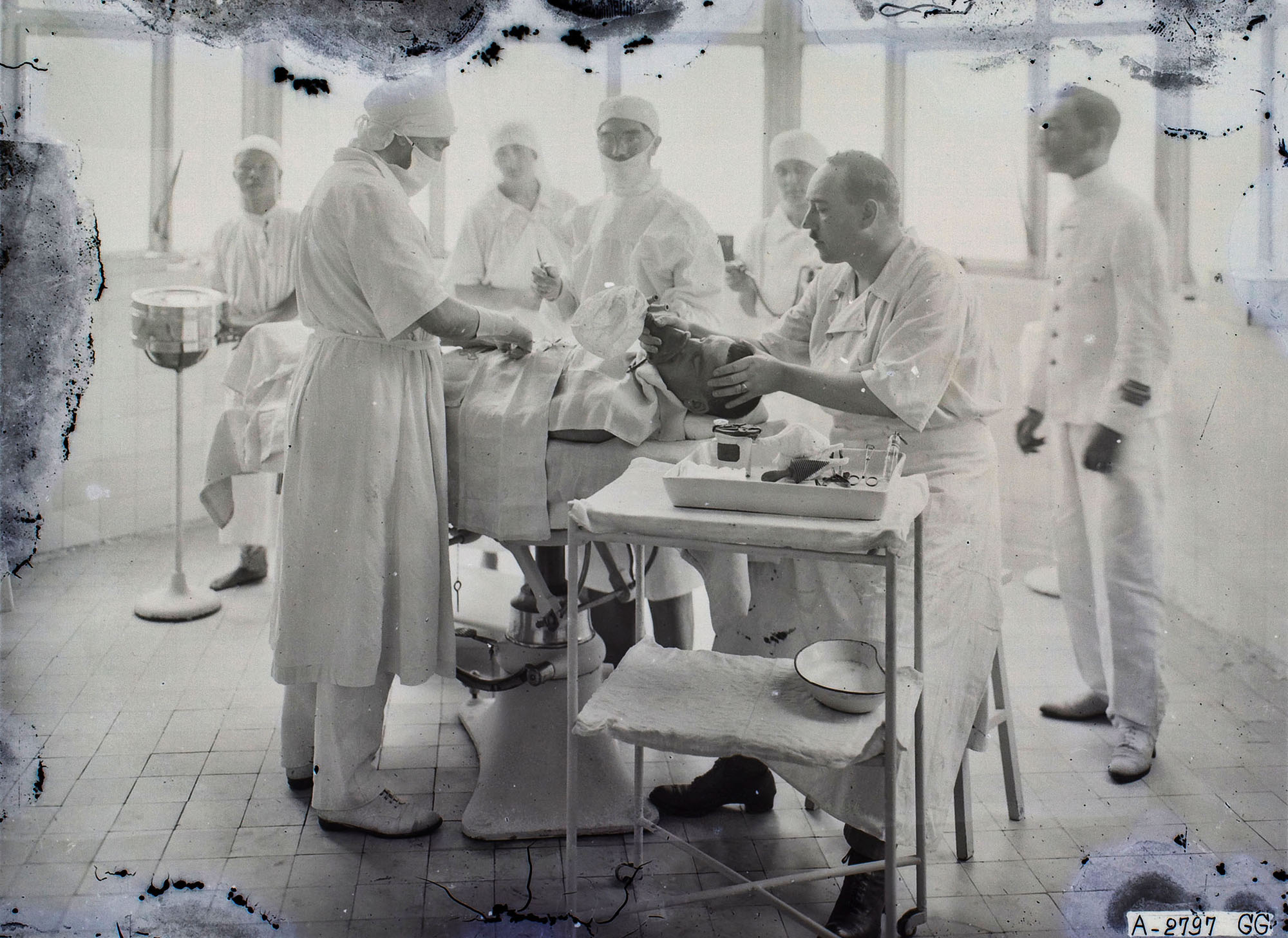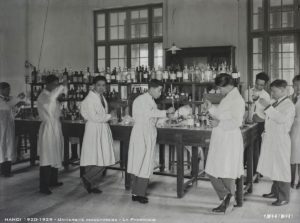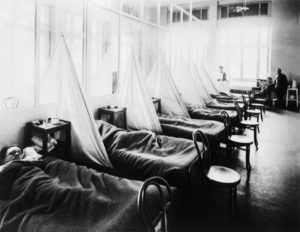
Saigon, 1920s – A l’hôpital militaire : une opération
Indochina has not been spared from the global infectious flu epidemic, firstly known as the “Spanish Flu,” which so painfully marked the years 1918 and 1919.
View the original French text here https://gallica.bnf.fr/ark:/12148/bpt6k5454600n/f77
As early as June 1918, the chief medical officer of the Canton Consular Medical Post reported that a “flu-like” condition had appeared in Canton and Hong Kong, where British doctors had labelled it “Influenza”. But this epidemic, although extremely contagious, was benign. The disease was characterised by the following symptoms: fever, sometimes preceded by chills, ranging from 37º5 to 39º5, generalised aches and pains in the muscles, headache, dizziness, laryngitis, cough, lack of appetite, and constipation. Objective examination revealed only rather insignificant signs: redness of the pharyngeal pillars, negative lung auscultation. No recurrence of the fever. The illness lasted a week, leaving behind fatigue and weight loss. No deaths.
This epidemic disappeared from Canton at the beginning of July 1918, but reappeared in October and November 1918, accompanied, then, by its formidable series of complications, which caused many deaths. The complications affected mainly the respiratory system, causing pulmonary congestion and edema.
 The flu made its appearance in July 1918 in the various territories of the Indochinese Union.
The flu made its appearance in July 1918 in the various territories of the Indochinese Union.
The epidemic reached its peak in August 1918, then gradually declined in September, without however completely disappearing. A new upsurge took place in October, and did not diminish until around April 1919.
The first epidemic wave, though considered relatively benign given the cases and deaths declared at the beginning of 1919, caused many fatalities.
From the morbidity and mortality point of view, we do not have many details on this period, having not initially required local government offices to make a compulsory declaration of influenza. But in many areas, provincial doctors estimate morbidity at 50% of the population.
Dr Bernard, Director of the Pasteur Institute in Saigon, detected, in a number of cases observed in Cochinchina, the presence of the Pfeiffer’s bacillus.
The breakdown by country of the cases and deaths which occurred during the months of November and December is as follows:
| Indochinese territories | Number of cases | Number of deaths |
| Tonkin and Kouang-Tchéou-Wan | 1,920 | 664 |
| Annam | 1,842 | 748 |
| Cochinchina | 168 | 21 |
| Cambodia | 1,092 | 240 |
| Laos | 2,361 | 165 |
| TOTAL | 7,383 | 1,838 |
These figures, being much lower than the reality, show that the epidemic was already severe in Indochina in 1918, since they exceeded by a third of the total cases of other epidemic diseases declared during that year.
In Tonkin, the epidemic was particularly severe:
– In Hà-Giang, on the border of China along the 3rd Military Territory, 600 deaths were observed during the month of December 1918: immediate measures were taken to limit the passage of Chinese across the border.
– In Sơn-La, amongst the local guards and the population of the provincial capital, 315 cases and 46 deaths were noted.
In Annam, the provinces of Thanh-Hoá (569 known deaths), Phan-Rang (299 cases), Tourane (266 cases) and Qui-Nhơn (250 cases) were most affected.

Crédit: Universal History Archive/Universal Images Group via Getty Images
No province of Cochinchina and Cambodia has been spared; in the latter country, the districts of Battambang, Stung-Treng, Kompong-Chhnang and Prey-Veng were the most affected.
In Laos, the flu appeared in August and September 1918 in the region below the 180th parallel, and in November and December it spread to Upper Laos; the provinces of Bassac and Attapeu, in Lower Laos, were particularly affected.
Prophylactic measures have been taken throughout Indochina to prevent the spread of the epidemic. The following circular, drawn up by the General Inspectorate of Sanitary and Medical Services, was communicated to the press at the beginning of November 1918 by the Government-General, with the intention of instructing the Indochinese population on the prophylactic measures, both individual and general, which it could take, and which would reduce the risk of contagion, at the same time as reducing the risks of pulmonary complications in those afflicted. It was distributed throughout all the territories of the Indochinese Union.
“For three months, an infectious disease, which is none other than the ‘flu’ or ‘influenza,’ has appeared in the various territories of the Indochinese Union, where it has formed some epidemic clusters; however, despite its widespread distribution, it has so far been relatively minor.
However, given that neighboring states have recently reported a greater virulence of this affection, transmission is expected to multiply during the winter season, possibly leading to pulmonary complications, always dangerous, for those affected.
The following measures may be taken advantageously to reduce the risk of contagion:
– Individual care of the nasal cavities, twice a day, morning and evening (instillation of gomenolato oil at 1/20 dilution or mentholated oil at 1/50 dilution), and of the throat (gargle morning and evening with iodized water at 1/1000 dilution);
– Avoid visiting the sick, who will be strictly isolated, and do not organise unnecessary large meetings;
– Wash, twice a day, the floors of houses, schools, offices, etc, using cresylated water.
The risks of pulmonary complications will be reduced considerably by practicing seriously, from the onset of the disease and throughout its duration, the individual treatments indicated above, to the nasal cavity and throat.”
Tim Doling is the author of the guidebooks Exploring Huế (Nhà Xuất Bản Thế Giới, Hà Nội, 2018), Exploring Saigon-Chợ Lớn (Nhà Xuất Bản Thế Giới, Hà Nội, 2019) and Exploring Quảng Nam (Nhà Xuất Bản Thế Giới, Hà Nội, 2020) and The Railways and Tramways of Việt Nam (White Lotus Press, 2012)
A full index of all Tim’s blog articles since November 2013 is now available here.

